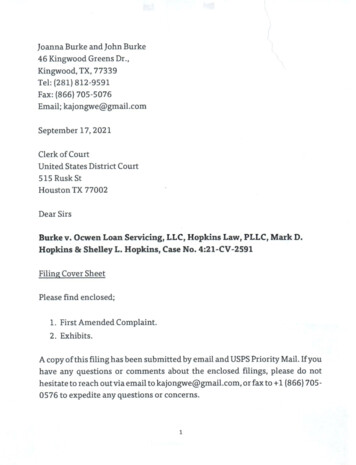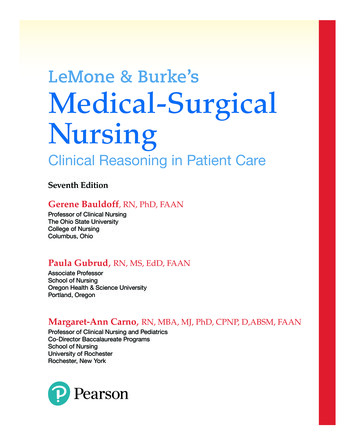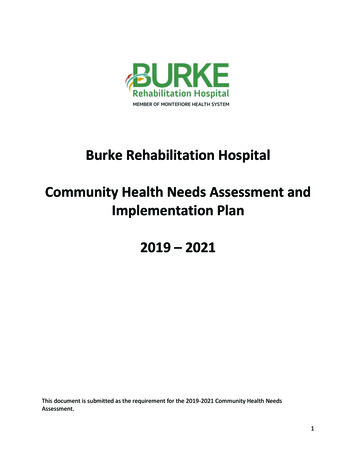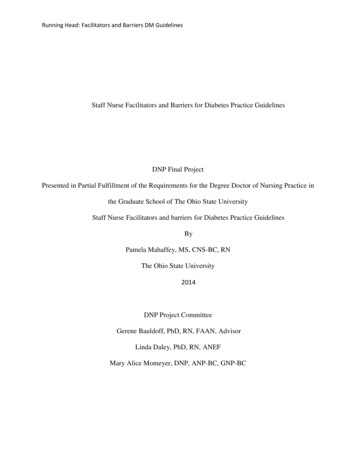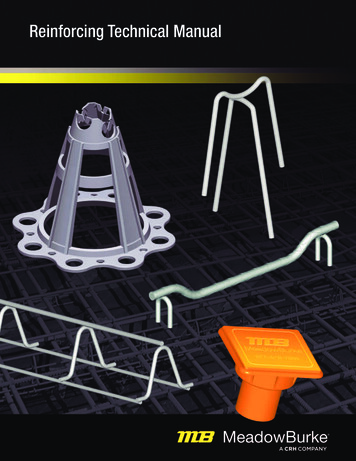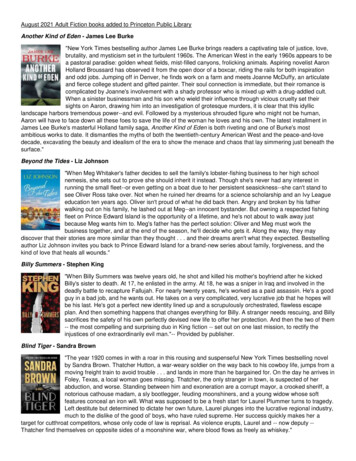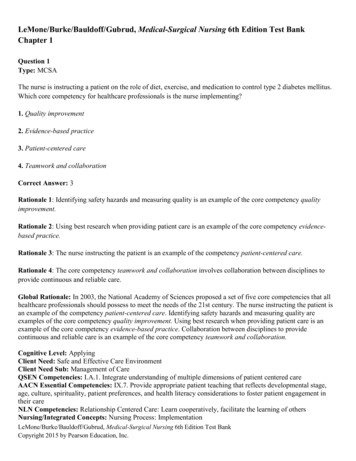
Transcription
LeMone/Burke/Bauldoff/Gubrud, Medical-Surgical Nursing 6th Edition Test BankChapter 1Question 1Type: MCSAThe nurse is instructing a patient on the role of diet, exercise, and medication to control type 2 diabetes mellitus.Which core competency for healthcare professionals is the nurse implementing?1. Quality improvement2. Evidence-based practice3. Patient-centered care4. Teamwork and collaborationCorrect Answer: 3Rationale 1: Identifying safety hazards and measuring quality is an example of the core competency qualityimprovement.Rationale 2: Using best research when providing patient care is an example of the core competency evidencebased practice.Rationale 3: The nurse instructing the patient is an example of the competency patient-centered care.Rationale 4: The core competency teamwork and collaboration involves collaboration between disciplines toprovide continuous and reliable care.Global Rationale: In 2003, the National Academy of Sciences proposed a set of five core competencies that allhealthcare professionals should possess to meet the needs of the 21st century. The nurse instructing the patient isan example of the competency patient-centered care. Identifying safety hazards and measuring quality areexamples of the core competency quality improvement. Using best research when providing patient care is anexample of the core competency evidence-based practice. Collaboration between disciplines to providecontinuous and reliable care is an example of the core competency teamwork and collaboration.Cognitive Level: ApplyingClient Need: Safe and Effective Care EnvironmentClient Need Sub: Management of CareQSEN Competencies: I.A.1. Integrate understanding of multiple dimensions of patient centered careAACN Essential Competencies: IX.7. Provide appropriate patient teaching that reflects developmental stage,age, culture, spirituality, patient preferences, and health literacy considerations to foster patient engagement intheir careNLN Competencies: Relationship Centered Care: Learn cooperatively, facilitate the learning of othersNursing/Integrated Concepts: Nursing Process: ImplementationLeMone/Burke/Bauldoff/Gubrud, Medical-Surgical Nursing 6th Edition Test BankCopyright 2015 by Pearson Education, Inc.
Learning Outcome: 1. Describe the core competencies for healthcare professionals: patient-centered care,interprofessional teams, evidence-based practice, quality improvement, safety, and health information technology.MNL Learning Outcome: 10.5.4. Utilize the nursing process in care of client.Page Number: 4Question 2Type: MCSAThe nurse is planning to utilize the core competency use informatics when providing patient care. Which actionshould the nurse perform when using this core competency?1. Change the sharps container in a patient’s room.2. Document the effectiveness of pain medication for a patient.3. Discuss the effectiveness of bedside physical therapy with the therapist.4. Search through a database of articles to find current research on wound care.Correct Answer: 4Rationale 1: Changing the sharps container is an example of quality improvement.Rationale 2: Documenting the effectiveness of pain medication for a patient is an example of patient-centeredcare.Rationale 3: Discussing the effectiveness of bedside physical therapy with the therapist is an example ofteamwork and collaboration.Rationale 4: Searching through a database of articles to find current research on wound care is an example of useinformatics.Global Rationale: Examples of the nurse using the core competency use informatics include the use oftechnology to communicate, manage knowledge, reduce errors, and support decision making. The activity ofsearching through a database of articles to find current research on wound care is an example of use informatics.Changing the sharps container in a patient’s room is an example of quality improvement. Documenting theeffectiveness of pain medication for a patient is an example of patient-centered care. Discussing the effectivenessof bedside physical therapy with the therapist is an example of teamwork and collaboration.Cognitive Level: ApplyingClient Need: Safe and Effective Care EnvironmentClient Need Sub: Management of CareQSEN Competencies: VI.B.2. Apply technology and information management tools to support safe processes ofcareAACN Essentials Competencies: IV.1. Demonstrate skills in using patient care technologies, informationsystems, and communication devices that support safe nursing practiceLeMone/Burke/Bauldoff/Gubrud, Medical-Surgical Nursing 6th Edition Test BankCopyright 2015 by Pearson Education, Inc.
NLN Competencies: Knowledge and Science: Electronic databases; literature retrieval; evaluating data forvalidity and reliability; evidence and best practices for nursingNursing/Integrated Concepts: Nursing Process: PlanningLearning Outcome: 1. Describe the core competencies for healthcare professionals: patient-centered care,interprofessional teams, evidence-based practice, quality improvement, safety, and health informationtechnology.MNL Learning Outcome: 4.3.3. Examine the treatments used for pressure ulcers.Page Number: 4Question 3Type: MCMAThe nurse plans to implement evidence-based practice when providing patient care. Which activities should thenurse perform?Standard Text: Select all that apply.1. Participate in education and research activities when possible.2. Integrate research findings with clinical care to maximize patient outcomes.3. Serve on the committee to create critical pathways for patient care.4. Reinforce hand hygiene techniques with unlicensed assistive personnel.5. Contact Environmental Services to report a malfunctioning infusion pump.Correct Answer: 1, 2Rationale 1: Participating in education and research activities when possible is an example of implementingevidence-based practice in the provision of patient care.Rationale 2: Integrating research findings with clinical care to maximize patient outcomes is an example ofimplementing evidence-based practice in the provision of patient care.Rationale 3: Serving on the committee to create critical pathways for patient care is an example of teamwork andcollaboration.Rationale 4: Reinforcing hand hygiene techniques with unlicensed assistive personnel is an example of qualityimprovement.Rationale 5: Contacting Environmental Services to report a malfunctioning infusion pump is an example ofquality improvement.Global Rationale: Participating in education and research activities when possible is an example of implementingevidence-based practice in the provision of patient care. Integrating research findings with clinical care tomaximize patient outcomes is an example of implementing evidence-based practice in the provision of patientLeMone/Burke/Bauldoff/Gubrud, Medical-Surgical Nursing 6th Edition Test BankCopyright 2015 by Pearson Education, Inc.
care. Serving on the committee to create critical pathways for patient care is an example of teamwork andcollaboration. Reinforcing hand hygiene techniques with unlicensed assistive personnel is an example of qualityimprovement. Contacting Environmental Services to report a malfunctioning infusion pump is an example ofquality improvement.Cognitive Level: ApplyingClient Need: Safe and Effective Care EnvironmentClient Need Sub: Management of CareQSEN Competencies: III.B.6. Participate in structuring the work environment to facilitate integration of newevidence into standards of practiceAACN Essentials Competencies: III.2. Demonstrate an understanding of the basic elements of the researchprocess and models for applying evidence to clinical practiceNLN Competencies: Knowledge and Science; Defining what is evidence-based practiceNursing/Integrated Concepts: Nursing Process: PlanningLearning Outcome: 1. Describe the core competencies for healthcare professionals: patient-centered care,interprofessional teams, evidence-based practice, quality improvement, safety, and health information technology.MNL Learning Outcome:Page Number: 4Question 4Type: MCSAThe community health nurse is planning to meet with several community members during a health fair. Whichnursing activity exemplifies the core competency patient-centered care?1. Provide smoking cessation classes and literature.2. Increase the hours for the physician to see patients.3. Attend a continuing education program on clean water initiatives.4. Evaluate the effectiveness of weight reduction strategies.Correct Answer: 1Rationale 1: Providing smoking cessation classes and literature is an example of an activity to provide patientcentered care.Rationale 2: Increasing the hours for the physician to see patients is an activity to support the competencyteamwork and collaboration.Rationale 3: Attending a continuing education program on clean water initiatives is an activity to support thecompetency evidence-based practice.Rationale 4: Evaluating the effectiveness of weight reduction strategies is an activity to support the competencyquality improvement.LeMone/Burke/Bauldoff/Gubrud, Medical-Surgical Nursing 6th Edition Test BankCopyright 2015 by Pearson Education, Inc.
Global Rationale: Activities to exemplify the core competency patient-centered care should be focused ondisease prevention, wellness, and promotion of healthy lifestyles. Providing smoking cessation classes andliterature is an example of patient-centered care. Increasing the hours for the physician to see patients is anactivity to support the competency teamwork and collaboration. Attending a continuing education program onclean water initiatives is an activity to support the competency evidence-based practice. Evaluating theeffectiveness of weight reduction strategies is an activity to support the competency quality improvement.Cognitive Level: ApplyingClient Need: Safe and Effective Care EnvironmentClient Need Sub: Management of CareQSEN Competencies: I.B.3. Provide patient-centered care with sensitivity and respect for the diversity of humanexperienceAACN Essentials Competencies: IX.3. Implement holistic, patient-centered care that reflects an understandingof human growth and development, pathophysiology, pharmacology, medical management and nursingmanagement across the health-illness continuum, across lifespan, and in all healthcare settingsNLN Competencies: Context and Environment; Knowledge; health promotion/disease preventionNursing/Integrated Concepts: Nursing Process: PlanningLearning Outcome: 1. Describe the core competencies for healthcare professionals: patient-centered care,interprofessional teams, evidence-based practice, quality improvement, safety, and health informationtechnology.MNL Learning Outcome: 5.9.4. Utilize the nursing process in care of client.Page Number: 4Question 5Type: MCSAThe nurse is instructing a patient on weight reduction and smoking cessation. Which code of nursing practice isthe nurse implementing?1. International Council of Nurses Code of Ethics for Nurses2. American Nurses Association Standards of Professional Practice3. American Nurses Association Code of Ethics for Nurses4. State Board of Nursing CodeCorrect Answer: 1Rationale 1: The International Council of Nurses (ICN) Code of Ethics for Nurses specifies what nurses areaccountable for in terms of people, practice, society, coworkers, and the profession. The philosophical basis forthis code is that nurses are responsible for promoting health, preventing illness, and alleviating suffering.Instructing a patient on weight reduction and smoking cessation exemplifies the ICN Code of Ethics for Nurses.LeMone/Burke/Bauldoff/Gubrud, Medical-Surgical Nursing 6th Edition Test BankCopyright 2015 by Pearson Education, Inc.
Rationale 2: The American Nurses Association Standards of Professional Practice are standards, not a code, andfocus on specific behaviors to address quality practice, practice evaluation, education, collegiality, collaboration,ethics, research, resource utilization, and leadership.Rationale 3: The American Nurses Association Code of Ethics for Nurses has nine statements that address thenurse’s professional relationships, commitment to patients, patient rights, nursing practice, competency,conditions of employment, and contributions to the science of nursing, collaboration, and nursing values.Rationale 4: The state boards of nursing do not publish codes for nursing.Global Rationale: The International Council of Nurses (ICN) Code of Ethics for Nurses specifies what nurses areaccountable for in terms of people, practice, society, coworkers, and the profession. The philosophical basis forthis code is that nurses are responsible for promoting health, preventing illness, and alleviating suffering.Instructing a patient on weight reduction and smoking cessation exemplifies the ICN Code of Ethics for Nurses.The American Nurses Association Standards of Professional Practice are standards, not a code, and focus onspecific behaviors to address quality practice, practice evaluation, education, collegiality, collaboration, ethics,research, resource utilization, and leadership. The American Nurses Association Code of Ethics for Nurses hasnine statements that address the nurse’s professional relationships, commitment to patients, patient rights, nursingpractice, competency, conditions of employment, and contributions to the science of nursing, collaboration, andnursing values. The state boards of nursing do not publish codes for nursing.Cognitive Level: ApplyingClient Need: Safe and Effective Care EnvironmentClient Need Sub: Management of CareQSEN Competencies: I.A.1. Integrate understanding of multiple dimensions of patient centered careAACN Essentials Competencies: VII.4. Use behavioral change techniques to promote health and manage illnessNLN Competencies: Context and Environment; Knowledge; health promotion/disease preventionNursing/Integrated Concepts: Nursing Process: ImplementationLearning Outcome: 4. Explain the importance of nursing and interprofessional codes of ethics and standards ofpractice as guidelines for clinical nursing practice.MNL Learning Outcome: 5.9.4. Utilize the nursing process in care of client.Page Number: 9Question 6Type: MCSAThe nurse is providing patient care within the American Nurses Association Standards of ProfessionalPerformance. Which activity is the nurse implementing?1. Integrating research findings into practice2. Implementing a patient’s plan of care3. Evaluating patient progress toward identified outcomes4. Analyzing assessment data to determine issuesLeMone/Burke/Bauldoff/Gubrud, Medical-Surgical Nursing 6th Edition Test BankCopyright 2015 by Pearson Education, Inc.
Correct Answer: 1Rationale 1: The nurse who is practicing within the American Nurses Association Standards of ProfessionalPerformance would integrate research findings into practice. The standards focus on ethics, education, evidencebased practice and research, quality nursing practice, communication, leadership, collaboration, professionalpractice evaluation, resource utilization, and environmental health.Rationale 2: Implementing a patient’s plan of care is an example of adhering to the American Nurses AssociationStandards of Practice.Rationale 3: Evaluating patient progress toward identified outcomes is an example of adhering to the AmericanNurses Association Standards of Practice.Rationale 4: Analyzing assessment data to determine issues is an example of adhering to the American NursesAssociation Standards of Practice.Global Rationale: The nurse who is practicing within the American Nurses Association Standards ofProfessional Performance would integrate research findings into practice. The standards focus ethics, education,evidence-based practice and research, quality nursing practice, communication, leadership, collaboration,professional practice evaluation, resource utilization, and environmental health. The other activities would beimplemented when the nurse is adhering to the American Nurses Association Standards of Practice.Cognitive Level: ApplyingClient Need: Safe and Effective Care EnvironmentClient Need Sub: Management of CareQSEN Competencies: III.B.6. Participate in structuring the work environment to facilitate integration of newevidence into standards of practiceAACN Essentials Competencies: III.2. Demonstrate an understanding of the basic elements of the researchprocess and models for applying evidence to clinical practiceNLN Competencies: Knowledge and Science; Defining what is evidence-based practiceNursing/Integrated Concepts: Nursing Process: ImplementationLearning Outcome: 4. Explain the importance of nursing and interprofessional codes of ethics and standards ofpractice as guidelines for clinical nursing practice.MNL Learning Outcome:Page Number: 10Question 7Type: MCSAThe nurse prescribes strategies and alternatives to assist a patient achieve expected outcomes. Within whichAmerican Nurses Association standard is the nurse practicing?1. Planning2. Assessment3. DiagnosisLeMone/Burke/Bauldoff/Gubrud, Medical-Surgical Nursing 6th Edition Test BankCopyright 2015 by Pearson Education, Inc.
4. ImplementationCorrect Answer: 1Rationale 1: The American Nurses Association Standards of Practice follow the nursing process. The nurse whoprescribes strategies and alternatives to assist a patient achieve expected outcomes is practicing within thestandard of planning.Rationale 2: Assessment activities include data collection.Rationale 3: Diagnosis activities include analyzing data to determine issues.Rationale 4: Implementation activities include implementing the identified plan, coordinating care delivery, andemploying strategies to promote health and a safe environment.Global Rationale: The American Nurses Association Standards of Practice follow the nursing process. The nursewho prescribes strategies and alternatives to assist a patient achieve expected outcomes is practicing within thestandard of planning. Assessment activities include data collection. Diagnosis activities include analyzing data todetermine issues. Implementation activities include implementing the identified plan, coordinating care delivery,and employing strategies to promote health and a safe environment.Cognitive Level: ApplyingClient Need: Safe and Effective Care EnvironmentClient Need Sub: Management of CareQSEN Competencies: I.B.3. Provide patient-centered care with sensitivity and respect for the diversity of humanexperienceAACN Essentials Competencies: IX.3. Implement holistic, patient-centered care that reflects an understandingof human growth and development, pathophysiology, pharmacology, medical management and nursingmanagement across the health-illness continuum, across lifespan, and in all healthcare settingsNLN Competencies: Context and Environment; Practice; conduct population-based transcultural healthassessments and interventionsNursing/Integrated Concepts: Nursing Process: ImplementationLearning Outcome: 4. Explain the importance of nursing and interprofessional codes of ethics and standards ofpractice as guidelines for clinical nursing practice.MNL Learning Outcome:Page Number: 10Question 8Type: MCSAA patient with a terminal illness is concerned about pain control. If the International Council of Nurses Code ofEthics for Nurses is followed, what should the nurse plan for the patient?1. Measures to alleviate suffering2. Modified activities of daily livingLeMone/Burke/Bauldoff/Gubrud, Medical-Surgical Nursing 6th Edition Test BankCopyright 2015 by Pearson Education, Inc.
3. Enforcement of strict bed rest4. Dietary interventions to maximize strengthCorrect Answer: 1Rationale 1: The philosophical basis for the International Council of Nurses Code of Ethics for Nurses is theresponsibility to promote health, prevent illness, and alleviate suffering. The nurse should plan measures toalleviate the patient’s suffering.Rationale 2: Modified activities of daily living may not affect pain control.Rationale 3: Enforcement of strict bed rest may not affect pain control.Rationale 4: Dietary interventions to maximize strength may not affect pain control.Global Rationale: The philosophical basis for the International Council of Nurses Code of Ethics for Nurses isthe responsibility to promote health, prevent illness, and alleviate suffering. The nurse should plan measures toalleviate the patient’s suffering. Modified activities of daily living, enforcement of strict bed rest, and dietaryinterventions to maximize strength may not affect pain control.Cognitive Level: ApplyingClient Need: Safe and Effective Care EnvironmentClient Need Sub: Management of CareQSEN Competencies: I.B.7. Initiate effective treatments to relieve pain and suffering in light of patient values,preferences and expressed needsAACN Essentials Competencies: IX.6. Implement patient and family care around resolution of end-of-life andpalliative care issues, such as symptom management, support of rituals, and respect for patient and familypreferencesNLN Competencies: Knowledge and Science; Practice; Translate research into practice in order to promotequality and improve practicesNursing/Integrated Concepts: Nursing Process: PlanningLearning Outcome: 4. Explain the importance of nursing and interprofessional codes of ethics and standards ofpractice as guidelines for clinical nursing practice.MNL Learning Outcome: 3.4.3. Critique interventions appropriate for the client with cancer.Page Number: 9Question 9Type: MCSAA patient is angry after waiting over an hour for pain medication. What should the nurse respond to the patientthat demonstrates critical thinking?1. “I understand your anger and am sorry for the delay. I have your pain medication now.”2. “I had other patients who needed my attention first, so I did a few things before getting the pain medication.”3. “I needed to find out what your medication is and if you can have more when you asked.”LeMone/Burke/Bauldoff/Gubrud, Medical-Surgical Nursing 6th Edition Test BankCopyright 2015 by Pearson Education, Inc.
4. “It seems that you always ask for pain medication when I am trying to do other things.”Correct Answer: 1Rationale 1: Critical thinking is evident when the nurse challenges assumptions, overtly identifies andacknowledges the values and beliefs he/she brings to the situation, considers the influence of context, generatespossible explanations, and deliberately maintains healthy skepticism. For the patient who is angry, this statementdemonstrates empathy and critical thinking.Rationale 2: This statement is not an example of critical thinking and would be an inappropriate response.Rationale 3: This statement is not an example of critical thinking and would be an inappropriate response.Rationale 4: This statement is not an example of critical thinking and would be an inappropriate response.Global Rationale: Critical thinking is evident when the nurse challenges assumptions, overtly identifies andacknowledges the values and beliefs he/she brings to the situation, considers the influence of context, generatespossible explanations, and deliberately maintains healthy skepticism. As the patient is angry, the statement thatdemonstrates empathy and critical thinking is “I understand your anger and am sorry for the delay. I have yourpain medication now.” The other choices are not examples of critical thinking and would be inappropriateresponses.Cognitive Level: ApplyingClient Need: Safe and Effective Care EnvironmentClient Need Sub: Management of CareQSEN Competencies: I.B.7. Initiate effective treatments to relieve pain and suffering in light of patient values,preferences and expressed needsAACN Essentials Competencies: IX.6. Implement patient and family care around resolution of end-of-life andpalliative care issues, such as symptom management, support of rituals, and respect for patient and familypreferencesNLN Competencies: Knowledge and Science; Practice; Translate research into practice in order to promotequality and improve practicesNursing/Integrated Concepts: Nursing Process: ImplementationLearning Outcome: 3. Apply the attitudes, mental habits, and skills necessary for clinical reasoning when usingthe nursing process in patient care.MNL Learning Outcome:Page Number: 4Question 10Type: MCSAThe nurse is reviewing data collected from a patient during an assessment. Which activity demonstrates that thenurse is using divergent thinking when analyzing this data?1. The nurse identifies abnormal data for further analyzing.2. The nurse focuses on normal data to rule out health problems.LeMone/Burke/Bauldoff/Gubrud, Medical-Surgical Nursing 6th Edition Test BankCopyright 2015 by Pearson Education, Inc.
3. The nurse discriminates between facts and guesses.4. The nurse thinks about the information to determine solutions.Correct Answer: 1Rationale 1: Divergent thinking, a critical-thinking skill, is the ability to weigh the importance of information.The nurse should sort out the data that are relevant from data that are irrelevant for the patient, remembering thatabnormal data are usually considered relevant.Rationale 2: Normal data are helpful but may not change the care to provide to the patient. This is not divergentthinking because it does not weigh the importance of the information.Rationale 3: Discriminating between facts and guesses describes the critical-thinking skill of reasoning.Rationale 4: Thinking about the information to determine solutions describes the critical-thinking skill ofreflection.Global Rationale: Divergent thinking, a critical-thinking skill, is the ability to weigh the importance ofinformation. The nurse should sort out the data that are relevant from data that are irrelevant for the patient.Abnormal data are usually considered relevant; normal data are helpful but may not change the care to provide tothe patient. Discriminating between facts and guesses describes the critical-thinking skill of reasoning. Thinkingabout the information to determine solutions describes the critical-thinking skill of reflection.Cognitive Level: ApplyingClient Need: Safe and Effective Care EnvironmentClient Need Sub: Management of CareQSEN Competencies: III.A.1. Demonstrate knowledge of basic scientific methods and processesAACN Essentials Competencies: III.6. Integrate evidence, clinical judgment, interprofessional perspectives andpatient preferences in planning, implementing, and evaluating outcomes of careNLN Competencies: Knowledge and Science; Practice; Translate research into practice in order to promotequality and improve practicesNursing/Integrated Concepts: Nursing Process: ImplementationLearning Outcome: 3. Apply the attitudes, mental habits, and skills necessary for clinical reasoning when usingthe nursing process in patient care.MNL Learning Outcome:Page Number: 4Question 11Type: MCSAThe nurse is identifying nursing diagnoses appropriate for a patient’s plan of care. What should the nurse use todetermine these diagnoses?1. Diagnostic reasoning2. Communication techniquesLeMone/Burke/Bauldoff/Gubrud, Medical-Surgical Nursing 6th Edition Test BankCopyright 2015 by Pearson Education, Inc.
3. Identified outcome criteria4. Established prioritiesCorrect Answer: 1Rationale 1: Making a diagnosis is a complex process, and the nurse uses diagnostic reasoning to choose nursingdiagnoses that best define the individual patient’s health problems. Diagnostic reasoning is a form of clinicaljudgment used to make decisions about which label, or diagnosis, best describes the patterns of data. Steps in theprocess include identifying significant cues, clustering the cues and identifying gaps, drawing conclusions aboutthe present health status, and determining etiologies and categorizing problems.Rationale 2: Communication techniques would be needed when conducting the patient assessment.Rationale 3: Identification of outcome criteria is a part of the planning phase of the nursing process.Rationale 4: Priorities are established during the implementation phase of the nursing process.Global Rationale: Making a diagnosis is a complex process, and the nurse uses diagnostic reasoning to choosenursing diagnoses that best define the individual patient’s health problems. Diagnostic reasoning is a form ofclinical judgment used to make decisions about which label, or diagnosis, best describes the patterns of data. Stepsin the process include identifying significant cues, clustering the cues and identifying gaps, drawing conclusionsabout the present health status, and determining etiologies and categorizing problems. Communication techniqueswould be needed when conducting the patient assessment. Identification of outcome criteria is a part of theplanning phase of the nursing process. Priorities are established during the implementation phase of the nursingprocess.Cognitive Level: ApplyingClient Need: Safe and Effective Care EnvironmentClient Need Sub: Management of CareQSEN Competencies: I.A.1. Integrate understanding of multiple dimensions of patient centered careAACN Essentials Competencies: III.6. Integrate evidence, clinical judgment, interprofessional perspectives andpatient preferences in planning, implementing, and evaluating outcomes of careNLN Competencies: Knowledge and Science; Practice; Translate research into practice in order to promotequality and improve practicesNursing/Integrated Concepts: Nursing Process: DiagnosisLearning Outcome: 3. Apply the attitudes, mental habits, and skills necessary for clinical reasoning when usingthe nursing process in patient care.MNL Learning Outcome:Page Number: 6Question 12Type: MCSAThe nurse plans and implements care for a patient based on nursing knowledge and skills. In which role is thenurse functioning?LeMone/Burke/Bauldoff/Gubrud, Medical-Surgical Nursing 6th Edition Test BankCopyright 2015 by Pearson Education, Inc.
1. Caregiver2. Advocate3. Educator4. LeaderCorrect Answer: 1Rationale 1: The caregiver role for the nurse today is both independent and collaborative. Nurses independentlymake assessments and plan and implem
nine statements that address the nurse's professional relationships, commitment to patients, patient rights, nursing practice, competency, conditions of employment, and contributions to the science of nursing, collaboration, and nursing values. The state boards of nursing do not publish codes for nursing. Cognitive Level: Applying
